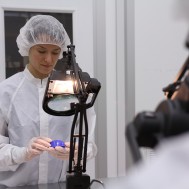The Production Part Approval Process (PPAP) functions as a standardized quality documentation process to record part specifications and approval requirements. Based on the information in the PPAP, it is determined whether the manufacturing process is capable of producing parts that meet required specifications.
Depending on specific customer requirements, PPAP’s can be tailored to report at various levels of detail. To complete a PPAP, there are a number of steps to follow in order to retrieve all necessary information. These steps include:
1. Design Record: Design records generally consist of a part print or drawing that is provided by the customer. A copy of the part print should be delivered with a PPAP to show the customer that the manufacturer is working with the correct design.
2. Process Flow Diagram: A Process Flow Diagram (PFD) provides a visual representation of how each manufacturing process will flow from start to finish, as well as determine the various quality checkpoints along the way. Each process flow diagram includes:
- A review of the process from raw materials to finished product
- Documentation of all manufacturing processes, quality control, decisions, documents and loops of the process
3. Process Failure Mode and Effects Analysis: A Process Failure Mode and Effects Analysis (PFMEA) is a risk assessment tool used to review and analyze a specific process to identify and document any potential challenges or associated risks. The PFMEA is designed to foster communication between process owners and subject matter experts, as well as identify areas in which additional action must be taken throughout the process.
4. Quality Control Plan: A Quality Control Plan identifies and lists manufacturing processes and their associated tools, specifications, control methods and reaction plans. The goal of planning ahead is to ensure that every operation within the flow of manufacturing is structured to meet specific quality standards.
5. Gage Repeatability and Reproducibility: A Gage R&R is used to ensure that the right equipment, engineers and operations are set in place to measure a rubber part accurately. This allows manufacturers to determine the amount of variability in a measurement system and guarantee that parts are measured consistently to match industry standards.
6. Dimensional Report of CTQ’s: CTQ stands for Critical to Quality. In this step, a dimensional inspection is performed and reported based on the needs and specifications of the customer. Dimensional inspections can be completed based on standards such as AS-9102 first article inspection.
7. Material Certification: Raw materials are quality tested to ensure they are free of any defects and that they are the right choice for the application requirements.
8. Capability Analysis: A capability analysis is conducted to determine if specific part dimensions will meet customer requirements. During this step, all drawings are reviewed for key characteristics and dimensions are inspected and confirmed for production.
9. ISO 9001 Certificate: ISO 9001 is the international standard for a quality management system. This standard is used to demonstrate Apple Rubber’s ability to meet customer standards and regulatory requirements.
10. Sample Parts: Sample parts are generated to ensure every dimension and material specification is correct for the application.
11. Part Submission Warrant: A Part Submission Warrant is a procedure in which the manufacturer provides evidence to the customer that all requirements are satisfied, including delivery date, quality documentation and production rate.
12. IMDs: The International Material Data System (IMDs) is a global data repository used to collect information on manufactured parts and materials in the automotive industry.
Want to learn more about quality documentation?
Contact an engineer today.
